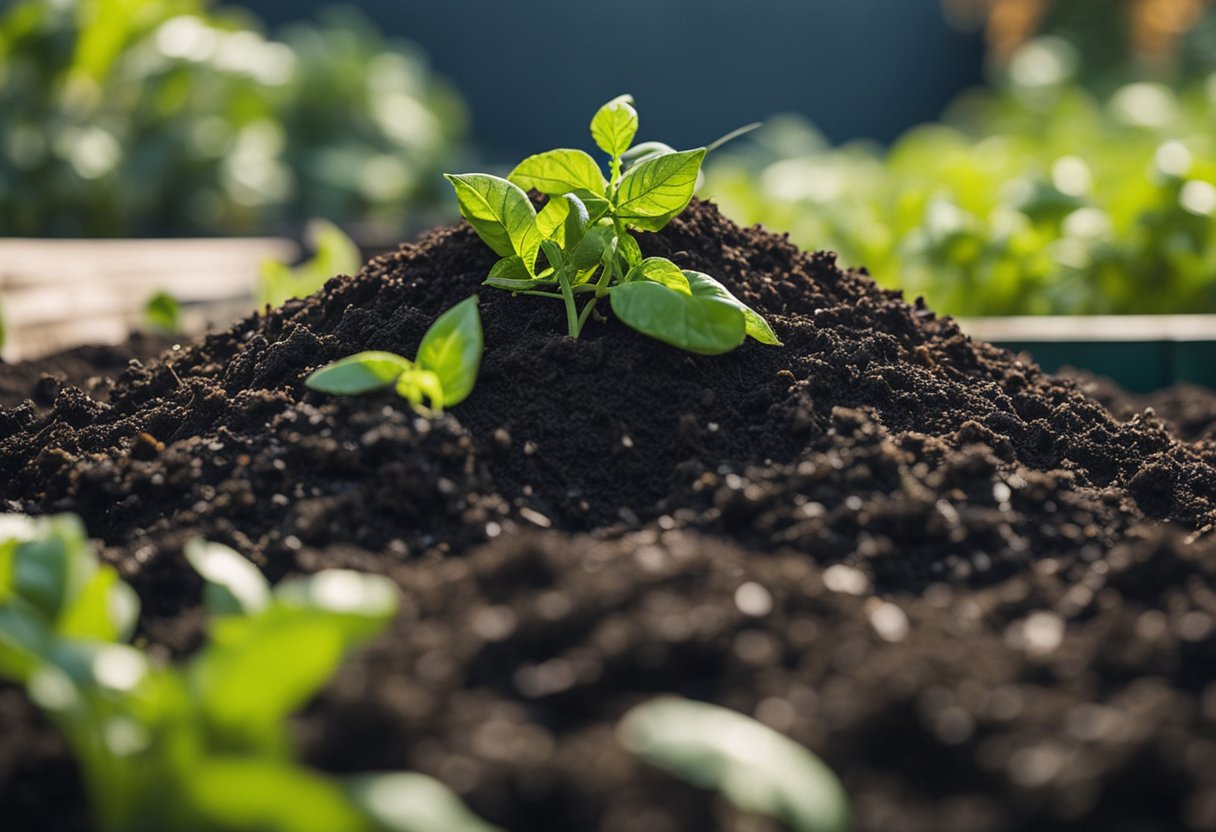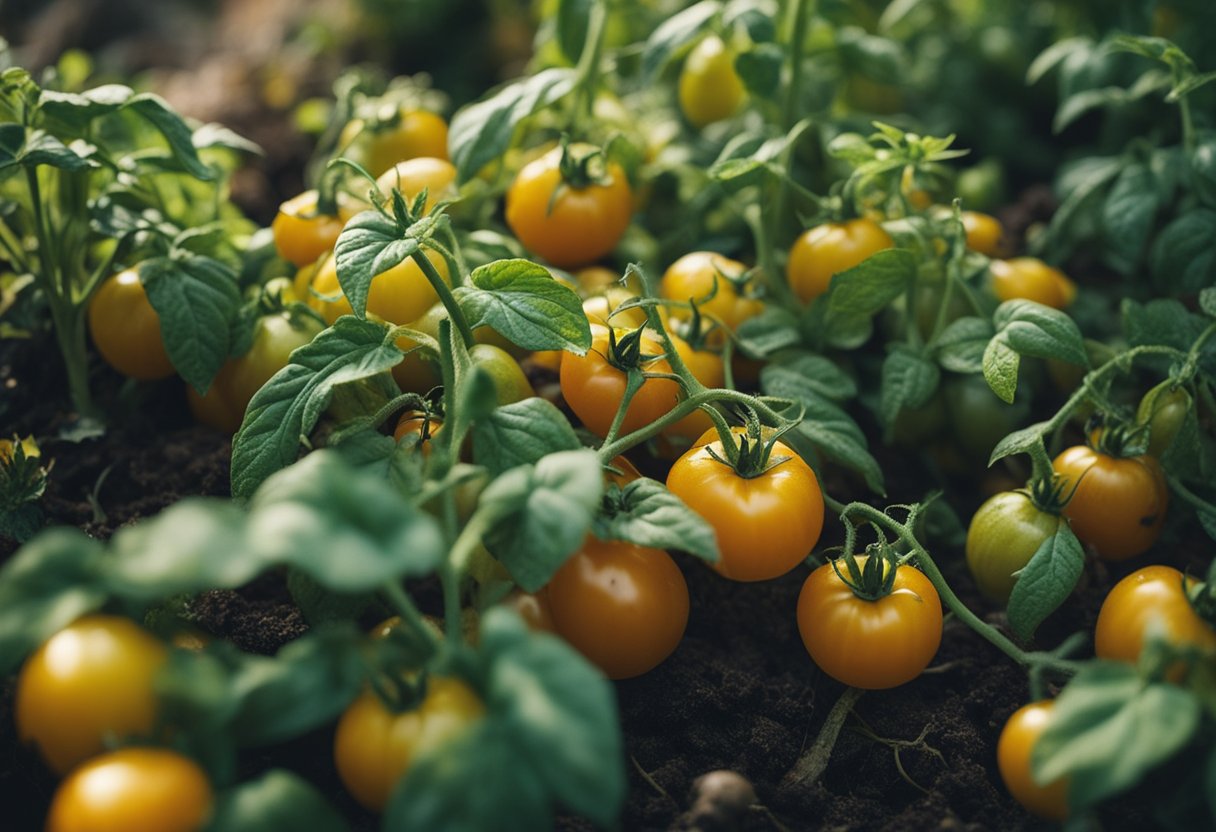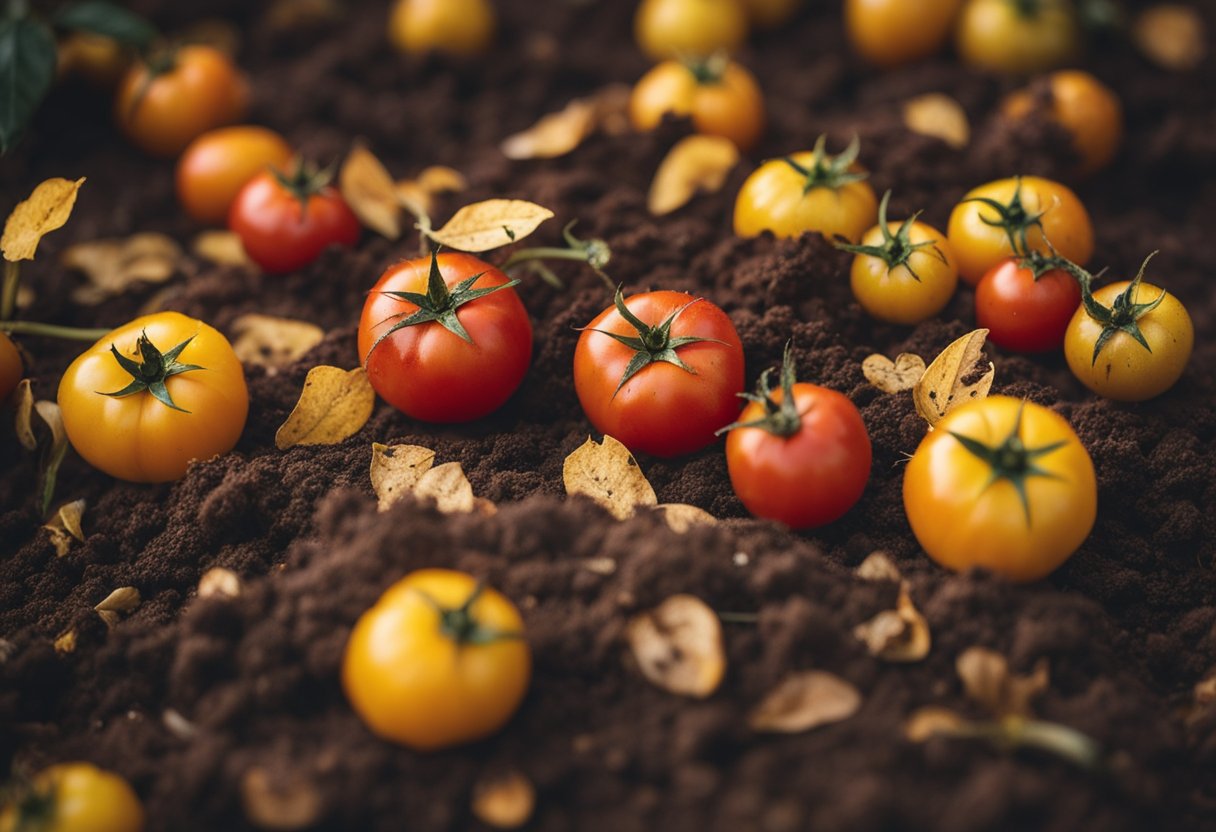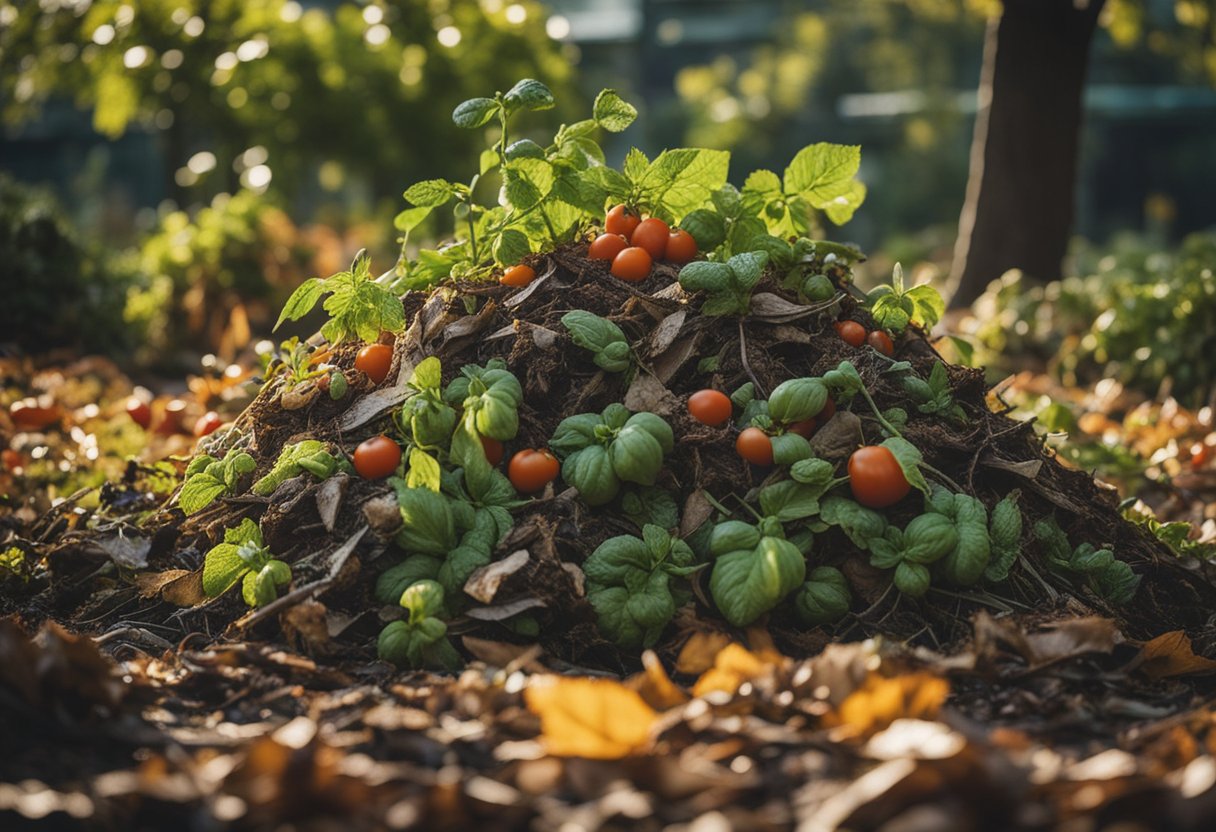As an Amazon Associate I earn from qualifying purchases.
At A Glance
Composting tomatoes infected with blight can be risky. Blight is caused by a fungus-like organism that can survive in soil and plant debris. If your compost pile doesn’t reach high enough temperatures to kill off the blight spores (at least 140°F or 60°C), it can spread the disease when the compost is later used. It’s generally advised against composting plants with blight to prevent the risk of future infections. Instead, consider disposing of blighted plants in the trash or burning them if local regulations allow.
When it comes to composting, many gardeners wonder if it’s safe to compost tomato plants with blight. The short answer is yes, you can compost tomato plants with blight, but there are a few things you should keep in mind.

Firstly, it’s important to ensure that the tomato plants are completely dead before adding them to your compost pile. If they are still alive, the blight could spread to other plants in the compost. Once you’re sure the plants are dead, you can add them to your compost pile as you would with any other plant material.
It’s also important to note that blight spores don’t remain in the soil or in compost, so you don’t have to worry about them infecting your plants in the future. However, if you want to be extra cautious, you can take steps to ensure that your compost pile reaches high temperatures that can kill off any remaining pathogens.
Understanding Tomato Blight

As a gardener, it is important to understand tomato blight and how it can affect your plants. Blight is a common term used to describe any number of fungal diseases that can affect plants, including tomatoes. Tomato blight is caused by the pathogen Phytophthora infestans, which is the same pathogen that causes potato blight.
There are two types of tomato blight: early blight and late blight. Early blight is caused by the fungus Alternaria solani and typically appears on the lower leaves of the plant. Late blight is caused by Phytophthora infestans and can affect the entire plant, including the fruit.
Blight spores can overwinter in the soil and infect plants the following year. The disease can also be spread by wind, rain, and contaminated tools. Symptoms of tomato blight include yellowing leaves, brown spots on the leaves and stems, and a general wilting of the plant.
It is important to properly dispose of any infected plants and avoid composting them. While some sources suggest that composting tomato plants with blight is safe, it is best to err on the side of caution and avoid composting infected plants. The spores can survive in the compost and infect other plants in the future.
In summary, tomato blight is a fungal disease that can devastate a tomato crop. It is caused by the pathogen Phytophthora infestans and can be spread by wind, rain, and contaminated tools. Symptoms of tomato blight include yellowing leaves, brown spots on the leaves and stems, and a general wilting of the plant. It is important to properly dispose of any infected plants and avoid composting them to prevent the spread of the disease.
Impacts of Blight on Tomato Plants
Blight is a fungal disease that can have devastating effects on tomato plants. It can affect every part of the plant, including the leaves, stems, and fruit. The disease is caused by a fungus-like organism that thrives in warm, moist conditions.
The most common types of blight that affect tomato plants are early blight and late blight. Early blight usually starts on the lower leaves of the plant and works its way up. It causes brown spots on the leaves that can eventually lead to defoliation. Late blight, on the other hand, starts on the upper leaves of the plant and can quickly spread throughout the entire plant. It causes dark, water-soaked spots on the leaves and stems, and can cause the fruit to rot.
In addition to blight, tomato plants can also be affected by other diseases, such as wilt viruses, curly top virus, fusarium wilt, verticillium wilt, and bacterial canker. These diseases can cause similar symptoms, such as wilting, yellowing, and stunted growth.
If your tomato plants are infected with blight or any other disease, it’s important to take action quickly. Infected plants should be removed from the garden and disposed of properly. Do not compost infected plants unless you can ensure that the compost pile reaches high enough temperatures to kill the fungus.
To prevent blight and other diseases from affecting your tomato plants, it’s important to practice good growing techniques. This includes planting disease-resistant varieties, rotating your crops, and providing proper spacing and ventilation to your plants. Additionally, avoid overhead watering, as this can create a moist environment that is ideal for the growth of fungal spores.
Tomato Blight Transmission

Tomato blight is a fungal disease that affects tomato plants and can cause significant damage to crops. It is caused by the pathogen Phytophthora infestans, which can be spread through various means. One of the most common ways that tomato blight is transmitted is through the spread of the disease from infected plants to healthy ones.
Rain and moisture play a significant role in the spread of tomato blight. The spores of the pathogen can be carried by raindrops and splashed onto nearby plants, infecting them. In addition, high humidity and dew can create ideal conditions for the growth and spread of the pathogen.
Air circulation is also an essential factor in preventing the spread of tomato blight. Poor air circulation can lead to the buildup of moisture, which can create ideal conditions for the growth of the pathogen. Adequate spacing between plants and the use of fans can help increase air circulation and prevent the spread of the disease.
Weather conditions can also impact the spread of tomato blight. Warm and wet weather is ideal for the growth and spread of the pathogen, while dry and cool weather can slow its growth and spread.
In conclusion, tomato blight can be transmitted through the spread of the disease from infected plants to healthy ones. Rain, moisture, air circulation, and weather conditions can all impact the spread of the disease. It is essential to take steps to prevent the spread of the disease, such as spacing plants adequately and increasing air circulation.
Composting Basics

Composting is the process of breaking down organic matter into a nutrient-rich soil amendment. The decomposition process is facilitated by microorganisms such as bacteria and fungi that break down the organic matter into smaller pieces. The resulting compost is rich in nutrients that plants need to grow and thrive.
To start composting, you will need a compost bin, compost pile, or compost heap. You can compost a variety of organic materials, including fruit and vegetable scraps, leaves, grass clippings, and yard waste. Tomatoes can also be composted, but if they have blight, there are a few things you need to keep in mind.
The decomposition process requires a balance of nitrogen and carbon. Nitrogen-rich materials such as grass clippings and vegetable scraps provide the energy needed for microorganisms to break down the organic matter. Carbon-rich materials such as leaves and woody branches provide the structure for the compost pile and help to maintain airflow. The ideal ratio of nitrogen to carbon is 1:3.
The temperature of the compost pile is also important for the decomposition process. A hot compost pile can reach temperatures of up to 160°F, which helps to kill off any pathogens or weed seeds that may be present in the organic matter. The high temperature also speeds up the decomposition process, so you can have compost ready in as little as a few weeks.
In summary, composting is a simple and effective way to turn your kitchen and yard waste into a nutrient-rich soil amendment. By following the basic principles of composting, you can create a healthy and thriving garden.
Risks of Composting Blighted Tomatoes
Composting is a great way to reduce waste and create nutrient-rich soil for your garden. However, when it comes to composting blighted tomatoes, there are some risks involved that you should be aware of.
Blight is a fungal disease that affects tomatoes and other plants. It is caused by spores that can be spread through the air, water, or contaminated soil. When you compost blighted tomatoes, you run the risk of spreading the disease to other plants in your garden.
While some sources suggest that composting blighted tomatoes is safe, it’s important to note that the spores that cause blight can survive in compost piles. This means that if you add infected plants to your compost pile, the spores may continue to live and spread the disease when you use the compost in your garden.
To reduce the risk of spreading disease, it’s important to make sure that any blighted plants you add to your compost pile are completely dead. This means that all leaves, stems, and roots should be brown and dried out before you add them to the pile. Additionally, it’s a good idea to avoid composting large quantities of blighted plants at once, as this can increase the risk of contamination.
If you do decide to compost blighted tomatoes, it’s important to monitor your compost pile closely for signs of disease. If you notice any signs of contamination, such as mold or fungus, it’s best to stop using the compost and dispose of it properly.
Overall, while composting blighted tomatoes is possible, it’s important to take precautions to reduce the risk of spreading disease. By following these tips, you can safely compost your tomato plants and create nutrient-rich soil for your garden.
Preventing Disease Spread in Compost
When composting tomato plants with blight, it is important to take precautions to prevent the spread of disease. Blight spores can survive in compost, so it is essential to kill them before adding the plants to the pile. Here are some tips to prevent disease spread in compost:
- Ensure that the compost pile reaches high temperatures: Hot temperatures can kill off harmful microorganisms, including blight spores. Aim for a temperature of at least 140 degrees Fahrenheit to ensure that the compost is properly heated.
- Avoid adding diseased plant material to the compost pile: Only add plant material that is free from disease to the compost pile. If you are unsure whether a plant is diseased, it is best to err on the side of caution and dispose of it in the trash.
- Turn the compost pile regularly: Turning the compost pile helps to distribute heat and oxygen throughout the pile, which can help to kill off harmful microorganisms.
- Use a compost thermometer: A compost thermometer can help you monitor the temperature of the compost pile and ensure that it reaches high enough temperatures to kill off harmful microorganisms.
- Allow the compost to mature before using: Mature compost is less likely to contain harmful microorganisms, so it is important to allow the compost to fully mature before using it in the garden.
By following these tips, you can help prevent the spread of disease in your compost pile and ensure that your plants stay healthy.
Alternative Disposal Methods
If you’re not comfortable composting tomato plants with blight, there are other disposal options available. One common method is burning the infected plants. This method is effective because it kills the fungus and prevents it from spreading to other plants. However, it’s important to check with your local authorities to ensure that burning is allowed in your area.
Another option is to bury the infected plants in a deep hole in the ground. The hole should be at least two feet deep and covered with soil. This method is effective because it prevents the fungus from spreading to other plants. However, it’s important to note that the plants may take a long time to decompose, and the hole should be located in an area where you don’t plan to grow plants in the future.
If burning or burying the plants is not an option, you can also place them in a sealed container and dispose of them in the trash. This method is effective because it prevents the fungus from spreading to other plants, but it’s important to note that the plants may still release spores even when sealed in a container.
When disposing of infected plants, it’s important to take precautions to prevent the spread of the fungus. Wear gloves and avoid touching healthy plants after handling infected ones. Additionally, clean any tools or equipment used to handle the infected plants to prevent the spread of the fungus.
Overall, there are several alternative disposal methods available for tomato plants with blight. Whether you choose to burn, bury, or dispose of them in a sealed container, it’s important to take precautions to prevent the spread of the fungus.
Preventing Blight in Your Garden
As a gardener, preventing blight in your tomato plants is crucial to ensure a healthy harvest. Blight is a fungal disease that affects tomato plants, causing the leaves to yellow and eventually die. There are two types of blight that commonly affect tomato plants: early blight and late blight.
To prevent blight in the garden, it is important to practice good garden hygiene. This includes rotating crops, removing diseased foliage, and fertilizing properly. Crop rotation is especially important because blight can remain in the soil for several years. By rotating crops, you can reduce the likelihood of blight taking hold in your garden.
Fertilizing properly is also important. Over-fertilizing can lead to excessive foliage growth, which can create a humid environment that is conducive to blight. It is recommended to use a balanced fertilizer with equal parts nitrogen, phosphorus, and potassium.
Good air circulation is also important in preventing blight. This can be achieved by spacing plants properly and pruning excess foliage. Drip irrigation is also recommended over overhead watering because it reduces the amount of moisture on the foliage.
Finally, if blight does occur, it is important to act quickly. Fungicides can be effective in treating blight, but they should be used as a last resort. Removing diseased foliage and improving air circulation can also help to prevent the spread of blight.
In summary, preventing blight in your garden requires good garden hygiene, proper fertilization, and good air circulation. By following these steps, you can reduce the likelihood of blight taking hold in your garden and ensure a healthy harvest of tomatoes.
Conclusion
In conclusion, composting tomato plants with blight is possible, but it requires careful consideration to prevent the spread of disease. Before adding the plants to the compost pile, make sure they are completely dead and free of any visible signs of disease. It is important to note that blight spores do not remain in the soil or compost, so composting the plants will not contribute to the spread of disease.
To ensure safe composting, it is crucial to manage the compost pile properly. A well-managed compost pile will reach high temperatures that will kill any remaining disease-causing organisms. It is also important to turn the pile regularly to ensure even decomposition and to maintain proper moisture levels.
Preventing blight in tomato plants is the best way to avoid the need to compost infected plants. Planting disease-resistant varieties and practicing good garden hygiene, such as removing infected plants and avoiding overhead watering, can help prevent the spread of disease.
Overall, composting tomato plants with blight is possible, but it requires careful management and attention to prevent the spread of disease. By following proper composting techniques and practicing good garden hygiene, you can turn your blighted tomato plants into nutrient-rich compost for your garden.
